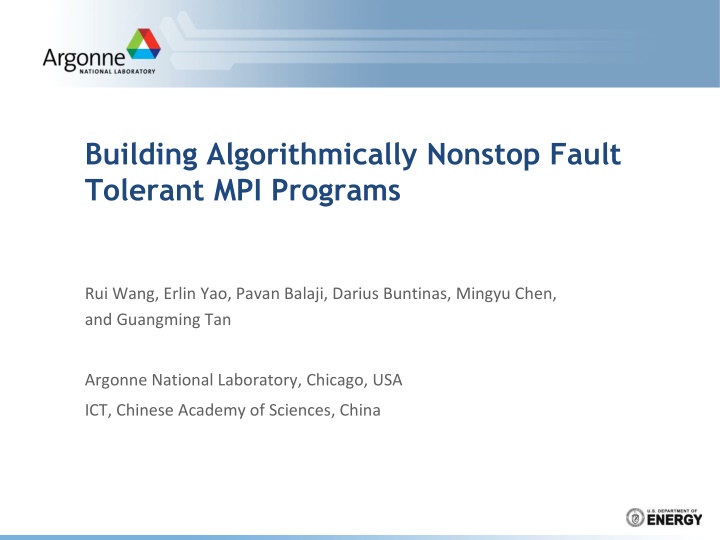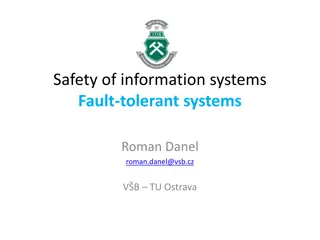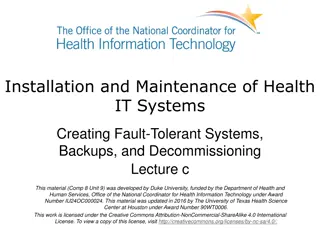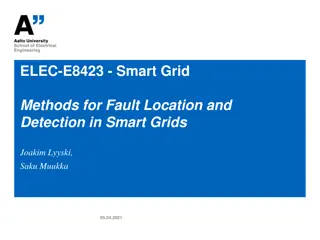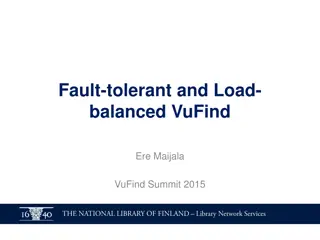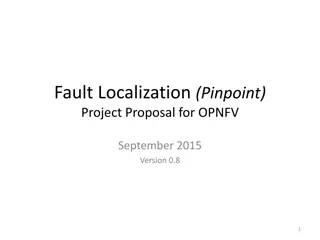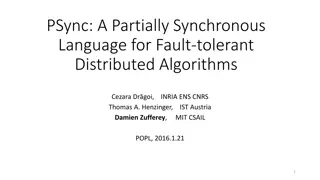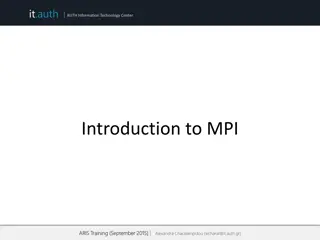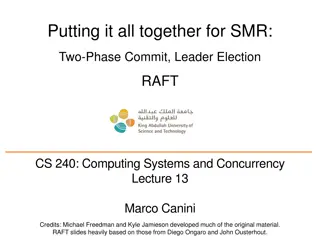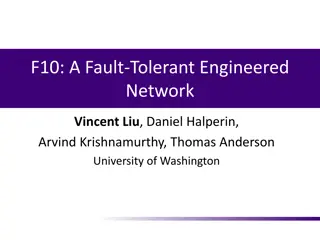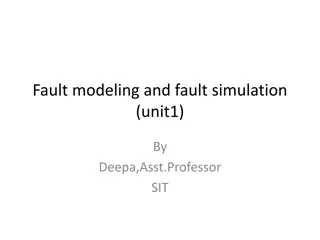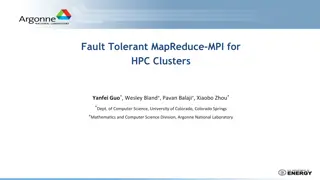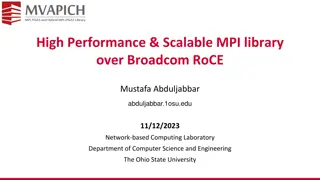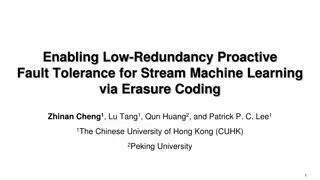Building Algorithmically Nonstop Fault Tolerant MPI Programs
Fault tolerance in large-scale supercomputers is a critical issue due to system failures. This article discusses hardware and software resilience techniques as well as Algorithm-based Fault Tolerance (ABFT) for building fault-tolerant MPI programs.
Download Presentation

Please find below an Image/Link to download the presentation.
The content on the website is provided AS IS for your information and personal use only. It may not be sold, licensed, or shared on other websites without obtaining consent from the author.If you encounter any issues during the download, it is possible that the publisher has removed the file from their server.
You are allowed to download the files provided on this website for personal or commercial use, subject to the condition that they are used lawfully. All files are the property of their respective owners.
The content on the website is provided AS IS for your information and personal use only. It may not be sold, licensed, or shared on other websites without obtaining consent from the author.
E N D
Presentation Transcript
Building Algorithmically Nonstop Fault Tolerant MPI Programs Rui Wang, Erlin Yao, Pavan Balaji, Darius Buntinas, Mingyu Chen, and Guangming Tan Argonne National Laboratory, Chicago, USA ICT, Chinese Academy of Sciences, China
Hardware Resilience for large-scale systems Resilience is a prominent becoming issue in large-scale supercomputers Exascale systems that will be available in 2018-2020 will have close to a billion processing units Even if each processing element fails once every 10,000 years, a system will have a fault once every 5 minutes Some of these faults are correctable by hardware, while some are not E.g., single bit flips are correctable by ECC memory, but double-bit flips are not Even for cases where hardware corrections are technologically feasible, cost and other power constraints might make then practically infeasible Pavan Balaji, Argonne National Laboratory HiPC (12/20/2011)
Software Resilience Software resilience is cheaper with respect to cost investment, but has performance implications The idea of most researchers working in this area is to understand this performance/resilience tradeoff Classical software resilience technique: system checkpointing Create a snapshot of the application image at some time interval and roll back to the last checkpoint if a failure occurs Transparent to the user, but stresses the I/O subsystem SystemsU RoadRunner LLNL BG/L Argonne BG/P Total SGI Altix IDRIS BG/P Perf. 1PF 500 TF 500 TF 100 TF 100 TF Ckpt time ~20 min. >20 min. ~30 min. ~40 min. 30 min. Source Panasas LLNL LLNL estimation IDRIS [Gibson, ICPP2007] Pavan Balaji, Argonne National Laboratory HiPC (12/20/2011)
Algorithm-based Fault Tolerance Recent research efforts in resilience have given birth to a new form of software resilience: Algorithmic-based Fault Tolerance (ABFT) A.k.a. Algorithmic fault tolerance, application-based fault tolerance Key idea is to utilize mathematical properties in the computation being carried out to reconstruct data on a failure No disk I/O phase, so the performance is independent of the file- system bandwidth Not 100% transparent for most applications that use math libraries for their computation this can be transparent, but for others it s not This work has mostly been done in the context of dense matrix manipulation operations, but the concept is applicable to other contexts too Pavan Balaji, Argonne National Laboratory HiPC (12/20/2011)
ABFT Recovery First proposed in 1987 to detect and correct instant errors at the VLSI layer Improved by Jack Dongarra to deal with node failures Concept: Add redundant nodes to store encoded checksum of the original data Re-design algorithm to compute original data and redundancy synchronously Recover corrupted data upon failure = + + D1 D2 D3 E = D2 E D1 D3 Pavan Balaji, Argonne National Laboratory HiPC (12/20/2011)
Deeper Dive into ABFT Recovery ABFT recovery pros: Completely utilizes in-memory techniques, so no disk I/O is required Utilizes additional computation to deal with node losses, so the amount of extra nodes required is fairly small (equal to the number of failures expected during the run) Important difference compared to in-memory checkpointing which requires twice the number of nodes ABFT recovery cons: Failure recovery is non-trivial Requires additional computation no problem; computation is free Requires all processes to synchronize every time there is a failure synchronization is not free, especially when dealing with >100,000 processes Pavan Balaji, Argonne National Laboratory HiPC (12/20/2011)
In this paper This paper improves on ABFT Recovery to propose a new methodology called ABFT hot replacement Idea is to utilize additional mathematical properties to not require synchronization on a failure Synchronization is eventually required, but can be delayed to a more natural synchronization point (such as the end of the program) We demonstrate ABFT hot replacement with LU factorization in this paper, though the idea is relevant to other dense matrix computations as well Might also work for sparse matrix computations, but is not as straightforward Also demonstrate LINPACK with our proposed approach Pavan Balaji, Argonne National Laboratory HiPC (12/20/2011)
Presentation Layout Introduction and Motivation Requirements from MPI and improvements to MPICH2 ABFT Hot Replacement Experimental Evaluation Concluding Remarks Pavan Balaji, Argonne National Laboratory HiPC (12/20/2011)
Fault Tolerance in MPI Minimum set of fault-tolerance features required Node failure will not cause the entire job to abort. Communication operations involving a failed process will not hang and will eventually complete. Communication operations will return an error code when it is affected by a failed process. This is needed to determine whether to re-send or re-receive messages The MPI implementation should provide a mechanism to query for failed processes. MPICH provides all these features and two forms of fault notification Asynchronous (through the process manager) Synchronous (through the MPI communication operations) Pavan Balaji, Argonne National Laboratory HiPC (12/20/2011)
Process Management and Asynchronous Notification Node 1 Node 0 P1 P2 P0 MPI Library MPI Library MPI Library Hydra proxy SIGUSR1 SIGUSR1 Hydra proxy SIGUSR1 SIGUSR1 FP List FP List P2 SIGCHLD SIGCHLD NULL P2 NULL mpiexec Pavan Balaji, Argonne National Laboratory HiPC (12/20/2011)
Synchronous Notification: Point-to-point Communication If a communication operation fails, an MPI_ERR_OTHER is returned to the application A message is sent to or a receive is posted for a message from a failed process For nonblocking operations, the error can be returned during the subsequent WAIT operation that touches the request Wildcard receives, i.e., using MPI_ANY_SOURCE create a special case, since we don t know who will send the data In this case, all processes that posted a wildcard receive would get an error Pavan Balaji, Argonne National Laboratory HiPC (12/20/2011)
Synchronous Notification: Collective Communication Collective operation does not hang, but some processes may have invalid results MPICH2 internally performs data error management Mark the messages carrying invalid data by using a different tag value. The process will continue performing the collective operation if a process receives a message marked as containing invalid data, but will mark any subsequent messages it sends as containing invalid data. From the application perspective: The collective operation will return an error code or if it had received invalid data at any point during the operation; otherwise, returns MPI_SUCCESS. Pavan Balaji, Argonne National Laboratory HiPC (12/20/2011)
Presentation Layout Introduction and Motivation Requirements from MPI and improvements to MPICH2 ABFT Hot Replacement Experimental Evaluation Concluding Remarks Pavan Balaji, Argonne National Laboratory HiPC (12/20/2011)
ABFT Hot Replacement ABFT Hot-replacement = + + D1 D2 D3 E P1 P4 P2 P3 ( ( 1 ) = D D D D D D Before the replacement, + 1 1 1 i i i n ) = ' D D D ED D After the replacement, + 1 1 1 i i n 1 Assume D =DT = T 1 1 1 Pavan Balaji, Argonne National Laboratory HiPC (12/20/2011)
ABFT Hot Recovery in LINPACK High Performance Linpack (HPL) benchmark for ranking supercomputers in top500 solve Ax = b CHECKSUM CHECKSUM CHECKSUM Each process generates its local random matrix A for i= 0, 1, LU factorization Ai= LiUi ; computation Broadcast Li right ;communication Update the trailing sub-matrix U solve upper-triangular Ux = L-1b to obtain x ; back substitution phase ; computation checksum relationship maintained Pavan Balaji, Argonne National Laboratory HiPC (12/20/2011)
Failure Handling in Computation Hot-Replacement Replace dead process column by redundant process column Background Recovery Recover the factorized data Requires additional computation, but is only local Matrix U is not upper-triangular any more Pavan Balaji, Argonne National Laboratory HiPC (12/20/2011)
Failure Handling in Computation (contd.) Before hot-replacement Ax = b After hot-replacement = ' A y b The correct solution x x = Ty This phase requires a global synchronization, but can be done at the end of the application (or some natural synchronization point) Pavan Balaji, Argonne National Laboratory HiPC (12/20/2011)
Failure Handling in Communication Broadcast phase : message forwarding Robust broadcast mechanism None of the processes will block if a failure occurs (MPI provides this) The error is notified to the application at least one process will know if an error occurred anywhere (MPI provides this) Either all non-failed processes receive the message successfully or none of them receive the message (MPI does not provide this yet) Additional communication required to ensure the global view of the broadcast is consistent 0 1 2 3 4 5 6 7 Pavan Balaji, Argonne National Laboratory HiPC (12/20/2011)
Presentation Layout Introduction and Motivation Requirements from MPI and improvements to MPICH2 ABFT Hot Replacement Experimental Evaluation Concluding Remarks Pavan Balaji, Argonne National Laboratory HiPC (12/20/2011)
Experimental Testbed Platform1: 17 nodes each with 4 quadcore 2.2 GHz Opteron processors (16-cores per node) Connected by Gigabit Ethernet Platform II: 8 blades, 10 Intel Xeon X5650 processors per blade Nodes in the same blade are connected by InfiniBand, while different blades are connected with each other by a single InfiniBand cable MPICH2: The work done was based on an experimental version of MPICH2 based on 1.3.2p1. The changes have been incorporated into MPICH2 releases as of 1.4 (and some more improvements incorporated into 1.5a1 and the upcoming 1.5a2) Pavan Balaji, Argonne National Laboratory HiPC (12/20/2011)
Performance Comparison of LINPACK Pavan Balaji, Argonne National Laboratory HiPC (12/20/2011)
Correctness Comparison Pavan Balaji, Argonne National Laboratory HiPC (12/20/2011)
Impact of Failure Occurrence Pavan Balaji, Argonne National Laboratory HiPC (12/20/2011)
Presentation Layout Introduction and Motivation Requirements from MPI and improvements to MPICH2 ABFT Hot Replacement Experimental Evaluation Concluding Remarks Pavan Balaji, Argonne National Laboratory HiPC (12/20/2011)
Concluding Remarks Resilience is an important issue that needs to be addressed Hardware resilience can only go so far, because of technology, power and price constraints Software resilience required to augment places where hardware resilience is not sufficient System checkpointing was the classical resilience method, but hard to scale to very large systems ABFT-based methods gaining popularity Use mathematical properties to recompute data on failure ABFT Recovery method previously proposed problem is that it requires synchronization between all processes on failure We proposed ABFT hot replacement, which deals with this problem Pavan Balaji, Argonne National Laboratory HiPC (12/20/2011)
Thank You! Email: balaji@mcs.anl.gov Web: http://www.mcs.anl.gov/~balaji
